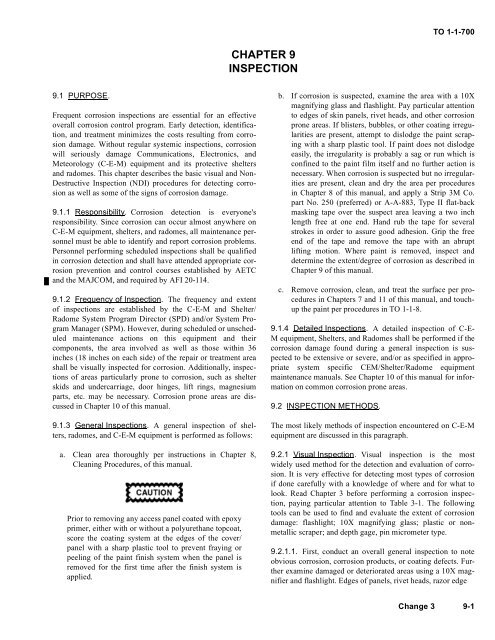TO 1-1-700 - Robins Air Force Base
TO 1-1-700 - Robins Air Force Base
TO 1-1-700 - Robins Air Force Base
You also want an ePaper? Increase the reach of your titles
YUMPU automatically turns print PDFs into web optimized ePapers that Google loves.
<strong>TO</strong> 1-1-<strong>700</strong><br />
CHAPTER 9<br />
INSPECTION<br />
9.1 PURPOSE.<br />
Frequent corrosion inspections are essential for an effective<br />
overall corrosion control program. Early detection, identification,<br />
and treatment minimizes the costs resulting from corrosion<br />
damage. Without regular systemic inspections, corrosion<br />
will seriously damage Communications, Electronics, and<br />
Meteorology (C-E-M) equipment and its protective shelters<br />
and radomes. This chapter describes the basic visual and Non-<br />
Destructive Inspection (NDI) procedures for detecting corrosion<br />
as well as some of the signs of corrosion damage.<br />
9.1.1 Responsibility. Corrosion detection is everyone's<br />
responsibility. Since corrosion can occur almost anywhere on<br />
C-E-M equipment, shelters, and radomes, all maintenance personnel<br />
must be able to identify and report corrosion problems.<br />
Personnel performing scheduled inspections shall be qualified<br />
in corrosion detection and shall have attended appropriate corrosion<br />
prevention and control courses established by AETC<br />
and the MAJCOM, and required by AFI 20-114.<br />
9.1.2 Frequency of Inspection. The frequency and extent<br />
of inspections are established by the C-E-M and Shelter/<br />
Radome System Program Director (SPD) and/or System Program<br />
Manager (SPM). However, during scheduled or unscheduled<br />
maintenance actions on this equipment and their<br />
components, the area involved as well as those within 36<br />
inches (18 inches on each side) of the repair or treatment area<br />
shall be visually inspected for corrosion. Additionally, inspections<br />
of areas particularly prone to corrosion, such as shelter<br />
skids and undercarriage, door hinges, lift rings, magnesium<br />
parts, etc. may be necessary. Corrosion prone areas are discussed<br />
in Chapter 10 of this manual.<br />
9.1.3 General Inspections. A general inspection of shelters,<br />
radomes, and C-E-M equipment is performed as follows:<br />
a. Clean area thoroughly per instructions in Chapter 8,<br />
Cleaning Procedures, of this manual.<br />
Prior to removing any access panel coated with epoxy<br />
primer, either with or without a polyurethane topcoat,<br />
score the coating system at the edges of the cover/<br />
panel with a sharp plastic tool to prevent fraying or<br />
peeling of the paint finish system when the panel is<br />
removed for the first time after the finish system is<br />
applied.<br />
b. If corrosion is suspected, examine the area with a 10X<br />
magnifying glass and flashlight. Pay particular attention<br />
to edges of skin panels, rivet heads, and other corrosion<br />
prone areas. If blisters, bubbles, or other coating irregularities<br />
are present, attempt to dislodge the paint scraping<br />
with a sharp plastic tool. If paint does not dislodge<br />
easily, the irregularity is probably a sag or run which is<br />
confined to the paint film itself and no further action is<br />
necessary. When corrosion is suspected but no irregularities<br />
are present, clean and dry the area per procedures<br />
in Chapter 8 of this manual, and apply a Strip 3M Co.<br />
part No. 250 (preferred) or A-A-883, Type II flat-back<br />
masking tape over the suspect area leaving a two inch<br />
length free at one end. Hand rub the tape for several<br />
strokes in order to assure good adhesion. Grip the free<br />
end of the tape and remove the tape with an abrupt<br />
lifting motion. Where paint is removed, inspect and<br />
determine the extent/degree of corrosion as described in<br />
Chapter 9 of this manual.<br />
c. Remove corrosion, clean, and treat the surface per procedures<br />
in Chapters 7 and 11 of this manual, and touchup<br />
the paint per procedures in <strong>TO</strong> 1-1-8.<br />
9.1.4 Detailed Inspections. A detailed inspection of C-E-<br />
M equipment, Shelters, and Radomes shall be performed if the<br />
corrosion damage found during a general inspection is suspected<br />
to be extensive or severe, and/or as specified in appropriate<br />
system specific CEM/Shelter/Radome equipment<br />
maintenance manuals. See Chapter 10 of this manual for information<br />
on common corrosion prone areas.<br />
9.2 INSPECTION METHODS.<br />
The most likely methods of inspection encountered on C-E-M<br />
equipment are discussed in this paragraph.<br />
9.2.1 Visual Inspection. Visual inspection is the most<br />
widely used method for the detection and evaluation of corrosion.<br />
It is very effective for detecting most types of corrosion<br />
if done carefully with a knowledge of where and for what to<br />
look. Read Chapter 3 before performing a corrosion inspection,<br />
paying particular attention to Table 3-1. The following<br />
tools can be used to find and evaluate the extent of corrosion<br />
damage: flashlight; 10X magnifying glass; plastic or nonmetallic<br />
scraper; and depth gage, pin micrometer type.<br />
9.2.1.1. First, conduct an overall general inspection to note<br />
obvious corrosion, corrosion products, or coating defects. Further<br />
examine damaged or deteriorated areas using a 10X magnifier<br />
and flashlight. Edges of panels, rivet heads, razor edge<br />
Change 3 9-1
















